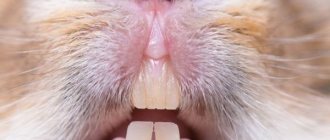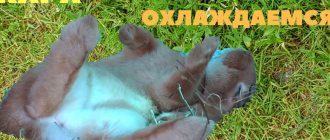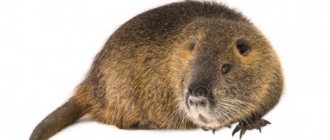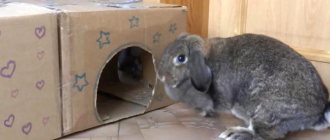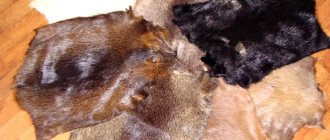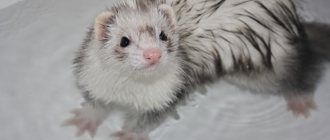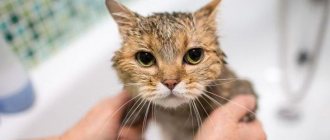Is it possible to wash rabbits?
There is no clear prohibition on washing rabbits (this applies to both decorative and ordinary animals), but in any case, this is not a natural procedure for them, which means that severe stress cannot be ruled out, which in some cases led to the death of fluffies.
In addition, frequent washing will help to remove the lubricant that moisturizes the skin, and this, in turn, threatens hair loss and increased itching.
In cool rooms, after bathing, the rabbit can catch a cold and then there will be more problems with them, therefore, when deciding to wash, take care that there are no drafts and a suitable air temperature.
Of course, there are situations when you can’t do without swimming. The fur of animals that have stained it with toxic substances or have been very heavily covered in dirt must be cleaned, because in such cases, licking off all the contaminants from themselves will only harm the body.
Of course, there is no longer a question of how often to wash, but it is advisable to protect your pet as much as possible from possible contact with pollutants.
Do you bathe regular, non-decorative rabbits? - most likely not, but even here it all depends on the situation: sometimes water procedures are simply necessary for the well-being of the animal, of course, if the benefit received exceeds the possible risk to its health (why it is considered that it is impossible to wash - has already been said).
Did you know? An ordinary average rabbit is capable of jumping 1 meter in height and 3 meters in length, but only if its physical activity has not been limited to a cramped cage for many years.
Why can't you bathe?
Why is it better not to bathe rabbits? From childhood we are taught that cleanliness is the key to health. Why do experienced rabbit breeders suggest leaving these animals without water treatments?
- Lagomorphs have no need for bathing. In the forest, in nature, hares do not swim and try to avoid rivers, lakes, etc. For them, bathing is unnatural. And decorative rabbits are more tender and weaker than wild animals.
- It's stressful. These animals are sensitive to stressful situations. Any stress affects their well-being, sometimes leading to death. Bathing is very stressful for them, so it is better to avoid it.
- No need. Rabbits are clean animals that regularly groom their fur. In addition, they shed every six months, so their fur is always clean and well-groomed. If the owner properly organizes the care of his pet: constantly cleans the cage, combs out the fur during shedding, then there is no need to wash the animal.
- Bathing is harmful to the rabbit. You should also not bathe your rabbit because it can lead to hair loss in your pet. The fur of this animal has a dense undercoat, which is covered with sebaceous secretions from the skin. They protect the villi from water, making them elastic, strong, and flexible.
If you bathe your rabbit, you wash away this natural defense. The result can be disastrous: the hair will begin to fall out.
Not all rabbits like to take water treatments.
When can you start swimming?
If we are talking about an ornamental animal, then cleaning measures are usually started only when the appearance of the animal and the condition of its fur are far from ideal.
This is typical for the following cases:
- in case of severe contamination, when cleaning the animal on its own will take a lot of time or it is very undesirable for its health (for example, if the wool has been in contact with chemical products);
- with diarrhea (trying to get rid of sticky feces, the rabbit may eat its own excrement, which will not have the best effect on its well-being);
- if there is a strong smell of urine (in this case, it is enough to carefully wash only the lower part of the animal’s body and paws if they have been in contact with urine);
- after heatstroke as a result of overheating (cold water will help normalize the furry's condition).
As you can see, in most cases, only partial cleaning of the fur is enough, which will be less stressful for the pet.
Frequently asked questions about bathing a decorative rabbit at home
Beginner rabbit breeders don’t know whether they need to wash their pet and, if necessary, how to do it? It should be noted that many owners are trying to find a definite answer, but this is fundamentally wrong. Some measures for caring for the animal may not be carried out, but some, such as washing when heavily soiled, are necessary.
Let's look at three common questions about the procedure for caring for an ornamental pet.
Why can't you bathe rabbits?
Rabbits are usually very clean and take care of themselves.
Most veterinarians have a negative attitude towards bathing ornamental animals. Although there is nothing terrible in the process itself, it is still worth noting that the washing procedure is undesirable. In some situations, bathing has negative consequences:
- Immersion in water is very stressful for a rabbit.
- Water getting into the ears, eyes or nose causes incurable diseases.
- Hypothermia and drafts while swimming can cause dangerous inflammation.
The listed diseases cause irreparable harm to the fragile health of the rabbit.
For prevention, it is necessary to clean your pet's eyes occasionally.
How to wash rabbits eyes?
As a preventive measure for eye diseases or when necessary, owners need to clean their pet's eyes. A special lotion is applied in a small amount to a cotton pad and removes impurities, moving from the outer corner of the eye to the inner. If necessary, the cleaned eye is treated again in the same order.
Cleansing lotion is sold at pet stores and is used as a hygienic treatment for the animal's eyes. Usually its use does not cause side effects, but if an allergy occurs, stop using the product.
Is it possible to blow dry a rabbit?
You can use a hair dryer to speed up the drying of the wool. However, it is better to do without it. This instrument makes a loud sound, which greatly frightens the already fearful rabbit. The owner must be attentive and determine by the pet’s well-being whether it is possible to use a hair dryer or not. Excessive manipulation can increase stress.
If you nevertheless decide to dry the animal’s fur with a hairdryer, then you need to turn it on at minimum speed and dry it at a distance of at least 50 cm. It is strictly forbidden to use the average and maximum power of the hairdryer.
Proper drying of a rabbit after bathing eliminates possible risks to its health.
What products should you use to wash your rabbit?
Sometimes just water is enough to wash away the dirt, but if you want to tidy up your rabbit's matted fur, then you will have to choose an effective washing product.
Human shampoo will not work here, just as animal shampoo containing sodium lauryl or laureth sulfate (this substance is dangerous to the health of your furry pet) will not work.
In modern veterinary pharmacies you can easily find shampoo designed specifically for decorative rabbits, so you should not wash your pet with cat or dog product.
It will also be useful for you to learn how to catch an escaped rabbit.
A special washing series will make the long-eared animal’s fur more shiny, make combing easier and prevent it from matting.
In addition to shampoo, in the same pet store or veterinary pharmacy you can purchase a special “rabbit” spray, which must be applied to the surface of its body and, rubbing the composition well with a cloth, comb the coat.
This spray cannot replace shampoo, but at the same time it perfectly fights skin problems and prevents the appearance of parasites, the main thing when applying is not to get it in the animal’s eyes.
As an alternative to standard shampoo, you can use a dry substance, which is useful when you don’t have a standard detergent on hand. All the owner needs is to apply the powder to the coat and, after evenly distributing it over the entire surface of the body, carefully comb it out with a comb.
Small stains will immediately disappear, and your rabbit's fur will become soft and silky.
Important! Whatever cleaning product you choose, it is important to use it very carefully, limiting contact with the animal’s eyes, ears and face. If you find it difficult to cope on your own, you should ask someone for help.
Products that can be used for washing
First of all, it is necessary to prepare the room in which swimming will take place. Most often this is the bathroom, but you can bathe in other rooms, the main thing is that it is warm there and there are no drafts, for which you need to close all the windows. You can wash your pet in a sink, bathtub or large basin. You should also take rabbit shampoo and a large towel. If you don't have shampoo, good baby soap can replace it. Regular and especially laundry soap cannot be used. The bathing product must be natural, without any admixture of aggressive substances, fragrances, dyes and other harmful chemicals.
How to properly bathe rabbits at home
If the animal takes good care of its fur, then there is no point in getting it completely wet. In this case, partial cleaning of only the contaminated area is suitable, but, be that as it may, each procedure must be performed in compliance with a clear order of actions.
Fully
Before you start bathing your rabbit, it is important to prepare everything you need for this procedure:
- basin;
- special shampoo;
- several soft towels;
- warm water heated to +36…+40 °C.
All windows and doors in the room must be tightly closed to eliminate the possibility of drafts.
The washing itself involves performing the following manipulations:
- Carefully place your pet in the bowl of water, gradually immersing his entire body in the liquid.
- Gently hold the fluffy with one hand, and wet all areas of the body except the head with the other.
- When the animal is completely wet, carefully apply a small amount of shampoo to the fur and spread it over the entire surface (except the head) with gentle massaging movements.
- Rinse off the shampoo, making sure that water does not get into the ears or face of the animal. It’s good if you prepare in advance another basin with clean warm water, where you can transplant the eared ear after the “bath” with shampoo.
- Make sure that all the shampoo is washed off, otherwise during the licking process the chemicals will get inside, causing intoxication of the body.
- Wrap a clean baby in a soft towel, and then dry it with another one: the first will absorb the flowing water, and the second will wipe the fur dry.
Important! There is no need to rub the rabbit too much. This will not only scare him, but may also cause pain. It’s best if he just sits wrapped up for a while and gradually dries out.
Partially
If we are talking about a rabbit, then this option is best suited. In order not to further injure the animal, only its paws, tail area or other contaminated areas of the body can be washed.
However, in this case, assistance in bathing will be even more important, because while one person is washing the animal, the second must hold it in a suitable position. For water procedures, in this case you can use a small basin with warm water (about +36 °C), placed in a room without drafts.
You will also need several towels and replacement water, especially if the dirt on the wool is abundant and clearly visible.
The process of “partial” bathing takes place according to the following scheme:
- Place a little shampoo in a bowl of water and stir until completely dissolved.
- Holding the animal well with one hand, wet the soiled part with water, being careful not to get the liquid into the ears, nose or eyes (if it is difficult to handle yourself, have someone else hold the pet while you wash it).
- Gently rub the dirty area with foam and rinse, and if necessary, replace the water in the basin.
- Rinse the fur well and rinse the animal again so that no soap marks remain on it.
- Dry the fur with a towel and release the rabbit onto a clean bedding.
- When washing the desired area, try not to wet the clean fur next to it: the larger the area is wet, the longer it will take to dry the animal so that it does not freeze.
Find out what not to feed your rabbit at home.
What to do after washing your pet
It is important that your pet does not remain wet after bathing, so it should be dried thoroughly. It’s better to do this with a towel, you can take several pieces. The fluffy should be taken and carefully wrapped in a towel, held for several minutes so that it absorbs moisture. It is important to dry your pet carefully so as not to damage its fur.
It is imperative to ensure that your pet is completely dry, as he may get sick. If your rabbit is not afraid of loud and sharp noises, you can use a hairdryer. It is important to set the temperature not too hot so as not to burn the animal. The hairdryer must be kept away from the pet and its face.
After bathing is over, it is important to cuddle your pet. Your rabbit may be offended for a long time due to the stress received, and therefore needs special care and attention. But it happens that over time they get used to the water and happily go to wash themselves.
Expert advice
Veterinarians are divided today about the possibility of washing rabbits.
While some categorically advise against using this method of cleansing, others allow a similar possibility, but subject to certain rules:
- the room should be warm enough, not lower than +22...+25 °C, without drafts;
- the rabbit itself must be completely calm, not scratch, not bite, and especially not squeal;
- Only special shampoos designed for delicate rabbit skin should be used as washing products;
- It is better not to use hair dryers and other noisy devices so as not to injure the animal;
- You need to wet the animal’s fur gradually, giving it time to get used to the water (the head should remain dry in any case);
- Shampoo should always be thoroughly rinsed off, otherwise there is a risk that chemicals will enter the fluffy’s body during the process of self-cleaning;
- after bathing, you should wrap the rabbit well and keep it there until it is completely dry, and only then release it onto the bedding;
- bathing a decorative eared pet should be done only in extreme cases: when it is overheated in the heat or when it is heavily soiled, which also applies to ordinary domestic rabbits;
- Partial washing of the animal should always be a priority, of course, if your pet is not completely dirty.
Did you know? Female rabbits are unique creatures that can bear two offspring at once, conceived from different males and at different times. The explanation for this phenomenon lies in their physiological feature - a bifurcated uterus.
In general, both decorative and ordinary rabbits can be called clean animals that do an excellent job of cleaning their fur on their own. This means that there is no need to worry too much about their hygiene and bathing can be very rare, even once every six months (be sure to comply with all the above rules).
General washing recommendations
If you are not confident in your own abilities, use the services of a groomer who bathes the rabbit without your participation. In other cases, follow the advice of experienced rabbit breeders:
- wash the animal together, since due to fear of water it can jump out, scratch and even bite;
- get used to bathing from an early age and gradually - first wash only the paws, then wet the back, but not with a large stream of water, but with a small stream;
- do not wet your ears or eyes with water, do not pour water on your face; when using the shower, check the nozzle to ensure that there are no unnecessary splashes on the sides (drops will get into your eyes and ears);
- if the rabbit has long hair and has formed tangles, then first they need to be trimmed and only after that water procedures are carried out, since wet clumps of wool are difficult to comb;
- immediately after washing, clean your ears with a cotton pad and a special lotion - movements should be light, do the same with your eyes;
- do not wash rabbits that are bearing offspring - stress and temperature changes lead to miscarriage;
- temporarily avoid water activities until the age of 1-1.5 months - babies still have weakened immunity, and their skin is too tender and sensitive;
- take into account the state of health - if the animal is sick, do not bathe it, wait until it recovers completely (otherwise the condition will worsen);
- Clean the cage in a timely manner - you won’t need to bathe it often.
Try to bathe your rabbit less often - it always creates a stressful situation for him, which is bad for his health. To do this, do not let him outside during bad weather, keep the room in which he lives clean, consult a veterinarian more often and get vaccinated, which is especially important on farms.
0
0
Copy link
